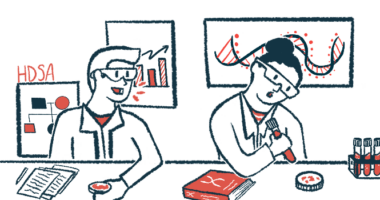Nerve Cell Development Appears Delayed in Juvenile Huntington’s, Stem Cell Study Reports

Stem cells created from cells taken from juvenile Huntington’s disease (JHD) patients showed a delay in developing into mature neurons, but one that is reversible, a study reports.
The study, “Characterization of Neurodevelopmental Abnormalities in iPSC-Derived Striatal Cultures from Patients with Huntington’s Disease,” was published in the Journal of Huntington’s Disease.
Huntington’s disease (HD) is caused by the expansion of repeating CAG nucleotides in the huntingtin gene (HTT) — giving rise to a mutant form of the huntingtin (mHTT) protein. Normally, CAG nucleotides are repeated 10 to 35 times. In people with HD, this repeating segment is longer.
Individuals with 36 to 40 CAG repeats develop a form of Huntington’s that is less severe and appears later in life, while those with more than 60 of these repeats progress to a severe disease form that starts much earlier, and is referred to as juvenile-onset HD (JHD).
Even though HTT is active throughout the body, the expanded CAG repeats in HTT mainly affects neurons in a part of the brain known as the striatum — a region that controls body movement.
Until recently, investigations into Huntington’s disease were limited due to a reliance on post-mortem human brain tissue samples.
With the discovery of embryonic stem cells — a fundamental type of cell that can become a wide variety of different cell types — scientists learned how to reprogram fully mature diseased cells back to a stem cell state before the disease progresses. This ability allows researchers to follow the growth and development of affected cells, and investigate the origins of the disease.
This was the approach used by investigators at Cedars-Sinai Medical Center in Los Angeles. The team isolated cells from JHD patients, reprogrammed them back to a stem cell state (called induced pluripotent stem cells (iPSC), and followed their growth and development to better understand the origins of HD.
They isolated cells from five JHD patients with expanded repeats of 60, 71, 109, and 180, and from four healthy subjects with 18, 21, 28, and 33 repeat segments who served as controls.
They grew the stem cells and allowed them to progress toward becoming striatum neuron cells — a process known as differentiation — and then repeatedly analyzed specific markers of neuron (nerve cell) development up to day 80 of cell growth.
Results revealed that after 14, 28, and 42 days of differentiation, cells producing a protein called nestin — a protein critical to the development of the central nervous system and a marker for cells that eventually become neurons (neural progenitor cells or NPCs) — were significantly over-represented in cell populations from HD patients compared to controls.
As the nestin protein is normally produced during the early stages of neuron development and stops after the cell becomes a neuron, the high percentage of nestin-expressing neural progenitor cells (neNPCs) represented a delay in the development of the JHD cells.
These results were consistent with the analysis of an HD mouse model that also showed a higher number of neural progenitor cells.
To determine whether the increase in neNPCs was reversible, the investigators reduced (knocked down) the expression of the HTT gene throughout the growth period. For this purpose, the team used different anti-sense oligonucleotides (ASOs, by Ionis Pharmaceuticals) that bind to a faulty HTT mRNA, targeting it for degradation and lowering the amount of abnormal HTT protein produced by the cell.
The reduction in mutant HTT protein production lowered the number of neNPCs.
(An ASO called IONIS-HTTRx [also called RG6042] is a potential treatment for Huntington’s disease, now being investigated in a global Phase 3 clinical trial (NCT03761849) by Roche that is enrolling patients at 101 sites across the U.S., Europe, and elsewhere. It was initially developed by Ionis.)
The population of neNPCs was also reduced following the inhibition of the NOTCH pathway, a signaling pathway important for cell to cell communication that promotes the growth of nerve cells.
“This study provides evidence to support the hypothesis of delayed development phenotype in the juvenile onset HD patient striatum,” Virginia Mattis, PhD, the study’s lead investigator with The Board of Governors Regenerative Medicine Institute and Department of Biomedical Sciences at Cedars-Sinai, said in a press release.
“This approach of disease modelling presents an ideal opportunity to study the early disease onset and its progression and can provide insight to understanding of the developmental aspects of juvenile HD,” Mattis added. “Better understanding the origins of disease could aid in targeting pathways of therapeutic intervention in the future.”






